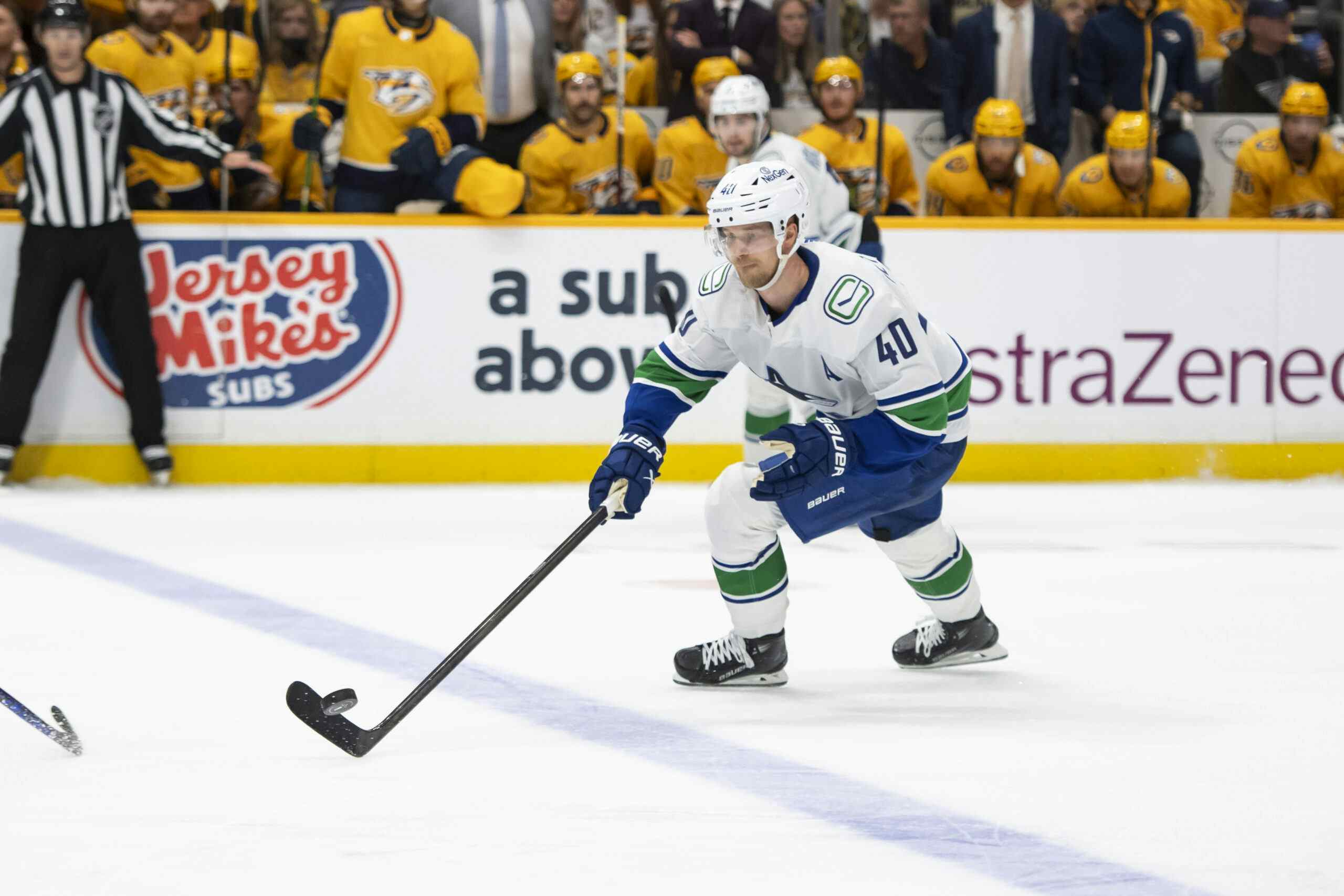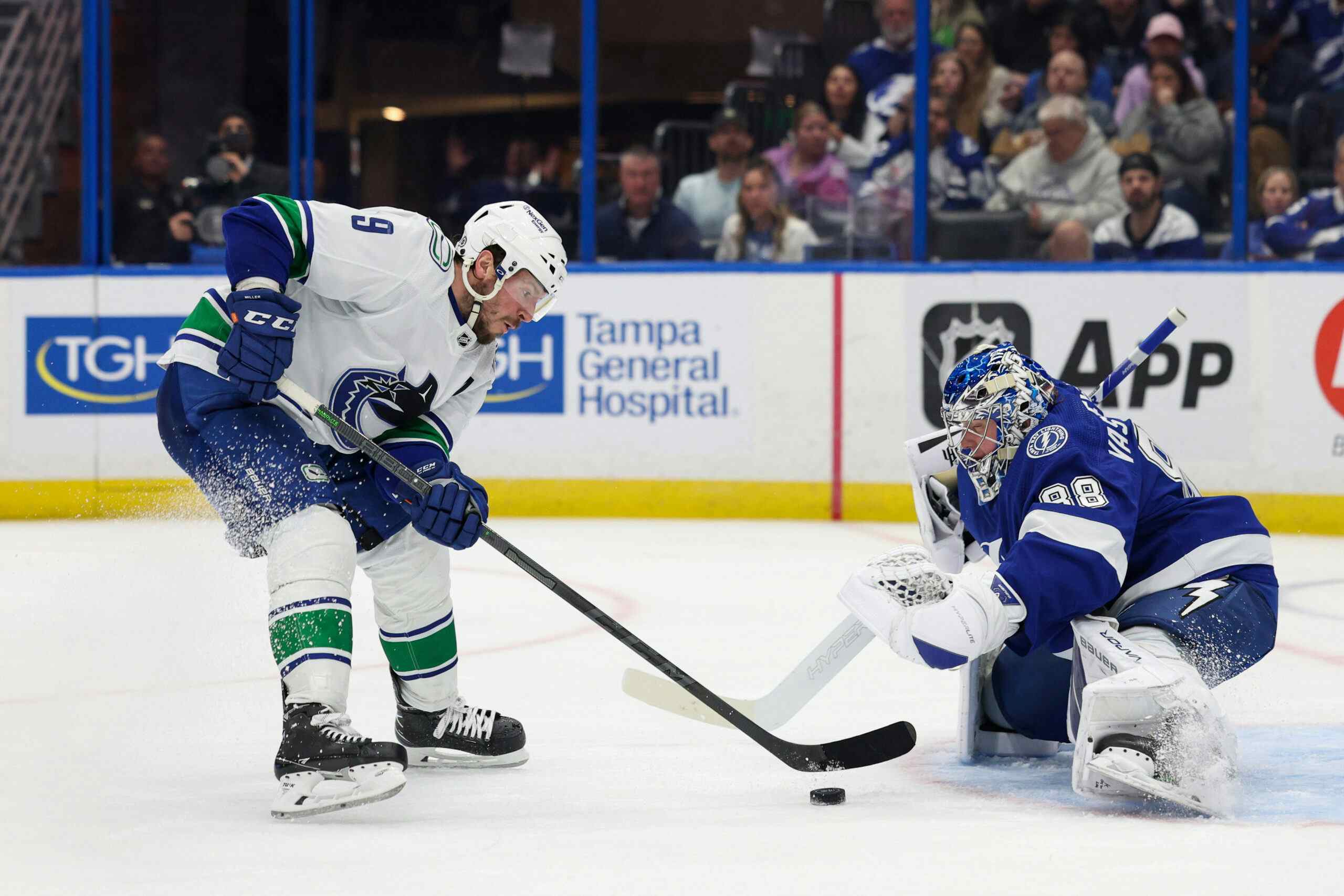2018 NHL Entry Draft: CHL Forwards to Watch
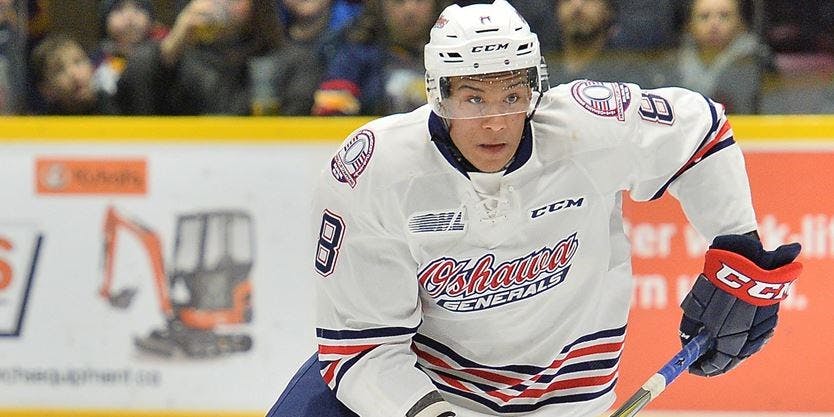
6 years ago
In August, fellow Canucks Army contributor Jeremy Davis did an excellent in-depth breakdown of the Top 15 prospects for the 2018 NHL Entry Draft. He then followed that up with a full Top 50 list.
So with Davis covering the Top 50, I wanted to take on the task of looking at some of the players that didn’t make the cut before the season began and who could see their stocks rise as we approach the draft in June.
It may be October, but that doesn’t mean we can’t start looking ahead to that draft class and begin tracking some players. Obviously, things will change between now and then but we can build our base of information and just keep adding to it over the course of the season.
With that, we’ll start with some CHL forward that didn’t make the Top 50 (well, one did) that look good under the statistical lens and are worth tracking.
Some of the players below have seen their stock rise over the past couple of weeks and are now getting some hype. But since they weren’t included in our Top 50, they are added here.
A Rundown of the Stats Used In These Articles
You can get draft lists from a myriad of sources, but since you came to Canucks Army, you can expect somewhat of a statistical lean. So, I’ve used the explanations that Jeremy used in his previous pieces to help explain what you might see in these posts.
- GF%: Percentage of 5-on-5 on-ice goals scored in favour of the player’s team.
- GF%rel: The difference between the player’s on-ice GF% relative to the team’s GF% when the player is off the ice.
- pGPS:
- xSucc is the Expected Success Rate for the player, based on how many similar players reached a 200 NHL game threshold, weighted by similarity.
- xPro/82 is the Expected Production of the player over 82 games, based on how similar players produced in the NHL, weighted by similarity.
- xVal is Expected Value, the product of xSucc and xPro/82. Check this article to see an Expected Value curve from last year’s draft to get an idea of what constitutes a “good” xVal. Last year the expected values in the first round ranged from about 35 to 15.
- SEAL: The SEAL adjusted scoring value. SEAL stands for Situational, Era, Age, and League. Here’s a rundown of the current iteration of SEAL, which evolved from a technique that Garret Hohl pioneered for the 2015 draft.
All of the pGPS numbers are based on their production last year. With only a handful of games for these players this year, it can create skewed numbers.
Without further ado, let’s dive in.
Milos Roman (Centre – Vancouver Giants – WHL)
Taken sixth overall in the 2017 CHL Import Draft, Milos Roman will make the jump across to North America ahead of his draft. Currently ranked as the 58th best prospect in the 2018 NHL Entry Draft by Future Considerations, Roman is a big bodied centre (6’0″ and 195 lbs) who should get plenty of opportunity with the Vancouver Giants this season.
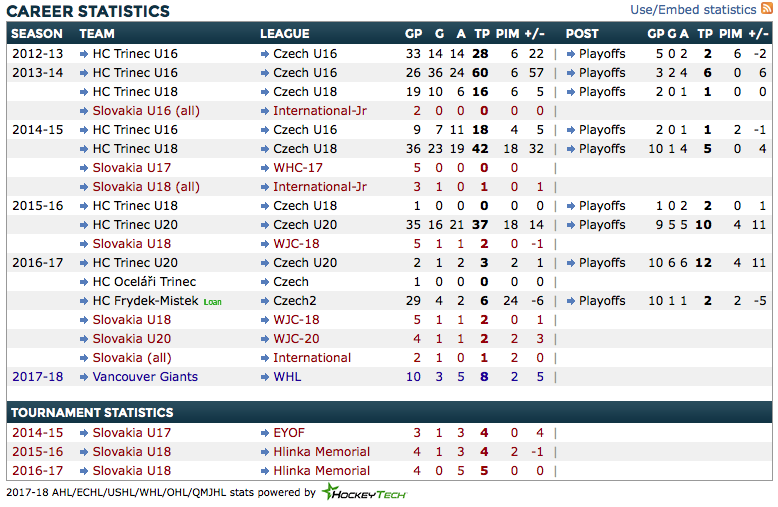
Roman hopped between the Czech League, second-tier Czech league and U20 leagues last year. He also represented Slovakia at the U18 and U20 tournaments.
Playing as a 16-year-old in the Czech League will always be looked upon fondly and pGPS backs that up with 18.7% of comparable players going onto becoming NHL regulars. That is obviously based on just one game in the top league, and thus there is a lot of variability to it. But the fact that he made that top league, has been a mainstay on the international level and is expected to be given a big role with the Giants means Roman is someone to keep an eye on for this year.
Roman has started the season well with eight points in ten games for the Giants.
Barrett Hayton (Centre – Sault St Marie Greyhounds – OHL)
A player who had a very noticeable Ivan Hlinka Memorial Cup performance was Sault St. Marie Greyhounds centre Barrett Hayton. Ending the tournament with three goals and three assists in five games, Hayton was someone who made an impact throughout the event.
He was given a more substantial role with Team Canada and made the most of it. It is worth noting that Hayton was limited in his role with the Greyhounds to third line duty. He averaged an estimated TOI of 12.2 minutes per game but still put up respectable production as a 16-year-old rookie. It’s worth noting that he played quite a bit of time on LW in the OHL, but is naturally a centre.
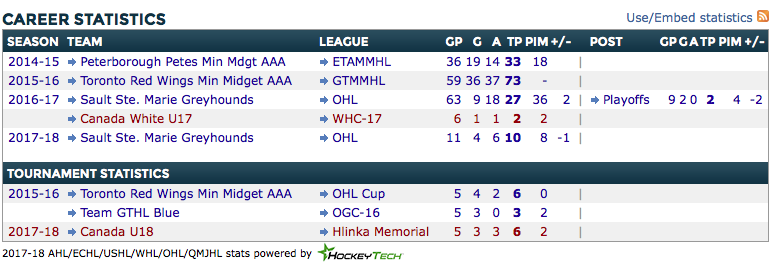
Despite the low ice time, his scoring rates were among to top of the 2018 Draft eligible forwards in the OHL. He was ninth in primary assists per game (0.14) and 10th in primary points per game (0.33) amongst that group. His 1.54 shots per game were ranked 12th in that group.
Hayton is primarily a playmaker, but if he can generate more shots, his production should reap the rewards. But more importantly, if he is given a more prominent role this season with the Greyhounds, he should quickly rise up the rankings. Despite the limited role, his production does look good when using pGPS as 20.7% (n=287) of comparable players went onto becoming NHL regulars.
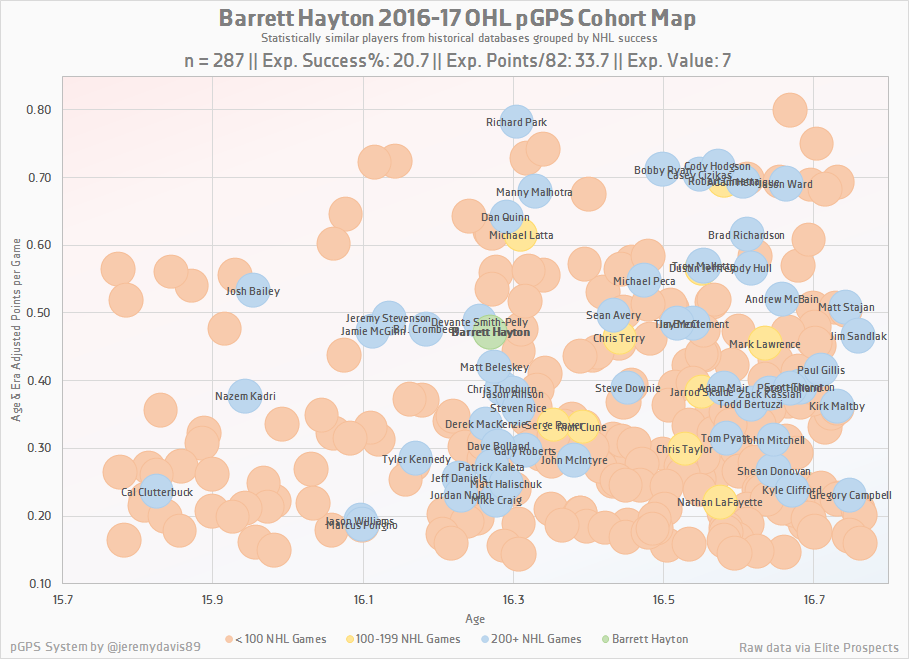
Hayton’s closest comparable players are Matt Beleskey and Devante Smith-Pelley, but there are some intriguing names in the mix that ended up with higher ceilings.
It’s worth noting that Craig Button has Hayton ranked as the eighth best prospect in this draft. But at this moment, he is the only one to have him ranked so high. Bob McKenzie had him ranked as the 15th best prospect in this year’s draft. So his stock has risen with a good Ivan Hlinka performance and good start to the OHL campaign.
Serron Noel (RW – Oshawa Generals – OHL)
The one player that cracked the Top 50 that I think could rise up further is Oshawa Generals forward Serron Noel. Noel only produced one goal at Ivan Hlinka, but he was noticeable throughout the entire event
Measuring in at 6’5″ and 200 lbs, Noel is a power forward with a relentless forecheck and work ethic. Brock Otten who cover OHL Prospects very closely had this to say about the Guelph, ON native:
Noel is a player who got better and better as the 2016/17 season went on. The massive winger (6’5, 200lbs) is also coming off a very impressive performance at this summer’s Hlinka where he played a key role on Canada’s gold medal winning squad. Love Noel’s intensity away from the puck. A tireless worker who is an excellent forechecker because of his wingspan and physical gifts. Has relatively impressive straight ahead speed for a big man too and drives the net with authority. Noel really has the potential to develop into a puck possession monster. I guess the big question I have is how much offensive potential does he have? Looks awkward when moving East/West and will need to work on his agility and balance. But if he can prove to be a quality goal scorer this year to go with the size and the impact he has without the puck, Noel is going to quickly climb up draft boards.
As Otten mentions, Noel’s skating is still a work in progress, and there are still questions about his offensive ceiling. But there is a lot to like about the hulking winger.

When we use pGPS to look at Noel, an impressive 19.8% of comparable players went onto becoming NHL regulars. If Noel can work on his skating and build off the momentum from the second half of his rookie season, he could see his draft stock rise as we head into Dallas.
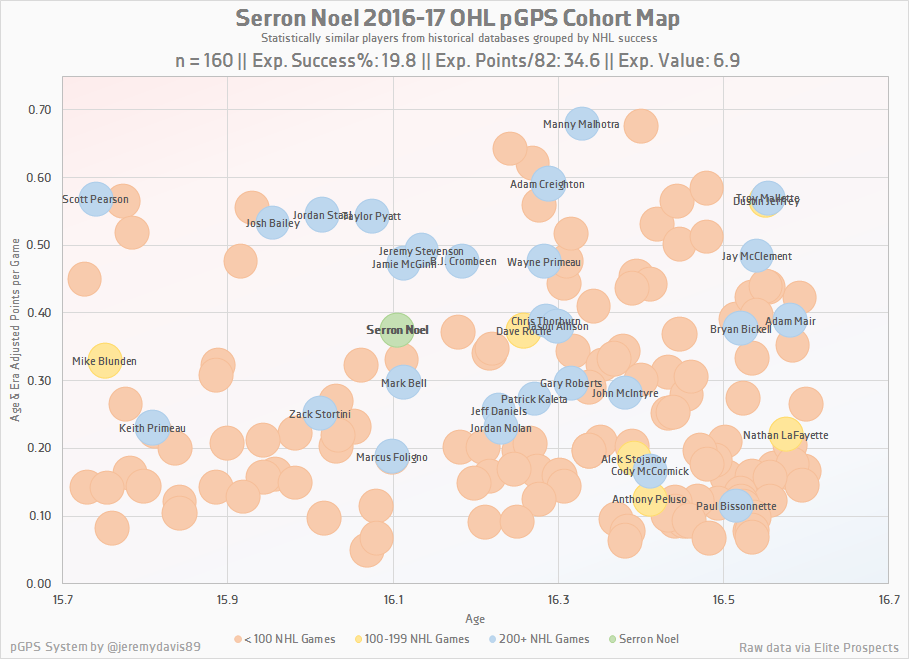
Noel has been outstanding to start the year with seven goals and four assists in nine games. He will be fun to track as the season progresses.
Semyon Der-Arguchintsev (RW – Peterborough Petes – OHL)
The 5’10” and 160 lbs Russian forward had a productive rookie season in the OHL this past season. He will be the youngest player in the 2018 NHL Entry Draft with his birthday being right on the cut-off date of September 15, 2000. We turn to Brock Otten again for a scouting report on the diminutive forward:
One of the more exciting players to watch in this age group because of his playmaking ability. Dazzles in puck control at times because he can keep the puck on a string. But also exhibits the vision to spot passing lanes and anticipates the play well. For a rookie, I thought he did a good job limiting his turnovers in the offensive end. He is undersized though (5’9) and he’ll need to continue to get quicker to make himself more elusive. And obviously adding strength will be crucial to filling out the rest of his game so he doesn’t have to constantly rely on his hands to create time and space. Potential is very high here.
What stands out at first glance for the Moskva, Russia native is that he had three goals and five assists in 12 playoff games for the Petes last season. That could be a good leaping off point for the young forward and something to build off of heading into next season.
Looking at some of the boxcar stats, Der-Arguchintsev does need to shoot more as his 0.86 SH/PG was 35th amongst draft-eligible forwards in the OHL for the 2016-17 season. Like all 16-year-old players, he played more of a depth role in his rookie season. With some more ice-time and shots, Der-Arguchintsev could be another player that sees his stock rise as we approach the draft.

Using pGPS to look at Der-Arguchintsev – an impressive 21.0% of comparable players went onto becoming NHL regulars (n=113). That is a high percentage with a good pool of comparable players to reference.
Michael Farren (C – Saskatoon Blades – WHL)
Another diminutive forward, measuring in at 5’10” and 160 lbs, closes out the group of CHL forwards to follow closely. Michael Farren of the Saskatoon Blades is looked upon nicely by pGPS with 18.6% of comparable players going onto becoming NHL regulars (n=237).
What’s even more impressive is that Farren was an undrafted and unsigned WHL prospect who forced his way onto the Blades roster. What stands about Farren is his on-ice vision and awareness of where his teammates are.

The theme continues here, but Farren was limited an eTOI of 11:49 per game, which is equal to a third line rate. His production surpassed that in every category, including his primary assists of 0.29 per game which is equal to first-line production.
The WHL was in the dark ages and doesn’t track shot data until this season – so we can’t use that as another angle of analysis for last year.
Farren has started this year a little slow with three assists in nine games.
A little more refinement to his skills, including puck handling and skating, and Farren could be a player worth our attention. The fact that he just forced his way onto the Blades roster is an encouraging sign. Maybe he just forces his way onto an AHL roster in a few years and then forces his way onto an NHL roster shortly after that. That drive and work ethic can’t be taught.
There are still tonnes of games left to be played, and players will see their draft stocks rise and fall as the year goes on. Look at Kole Lind, projected to be a late second or early third round pick to start the year, Lind had a fantastic second half to be selected 33rd overall.
As mentioned off the top, it is early, but you can now see these games with a little more information on a few players that could hear their names called early in the 2018 NHL Entry Draft.



